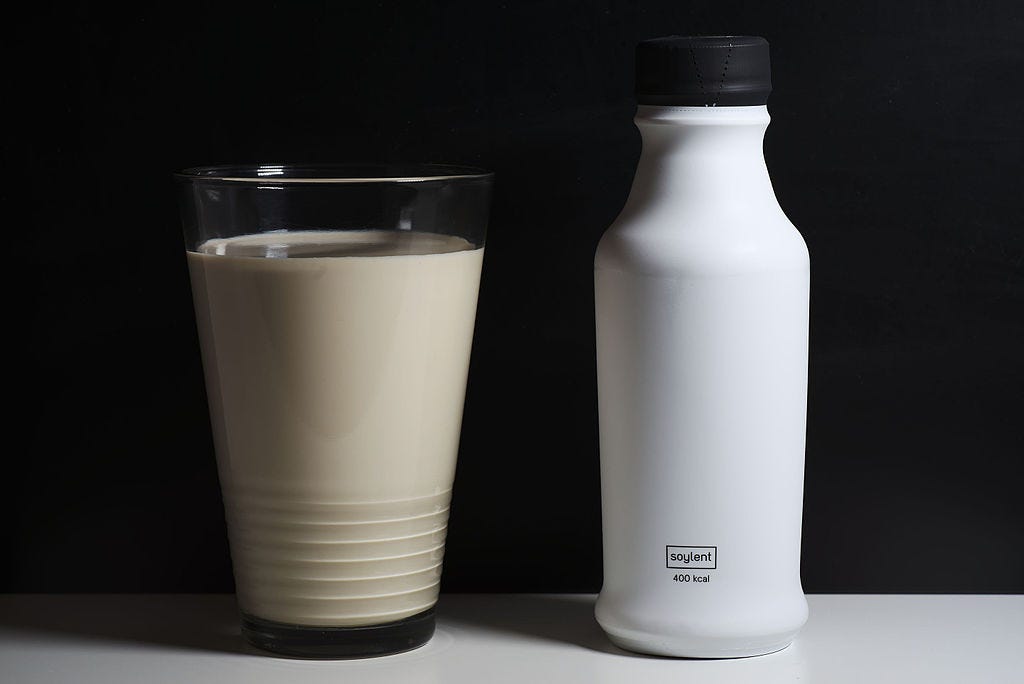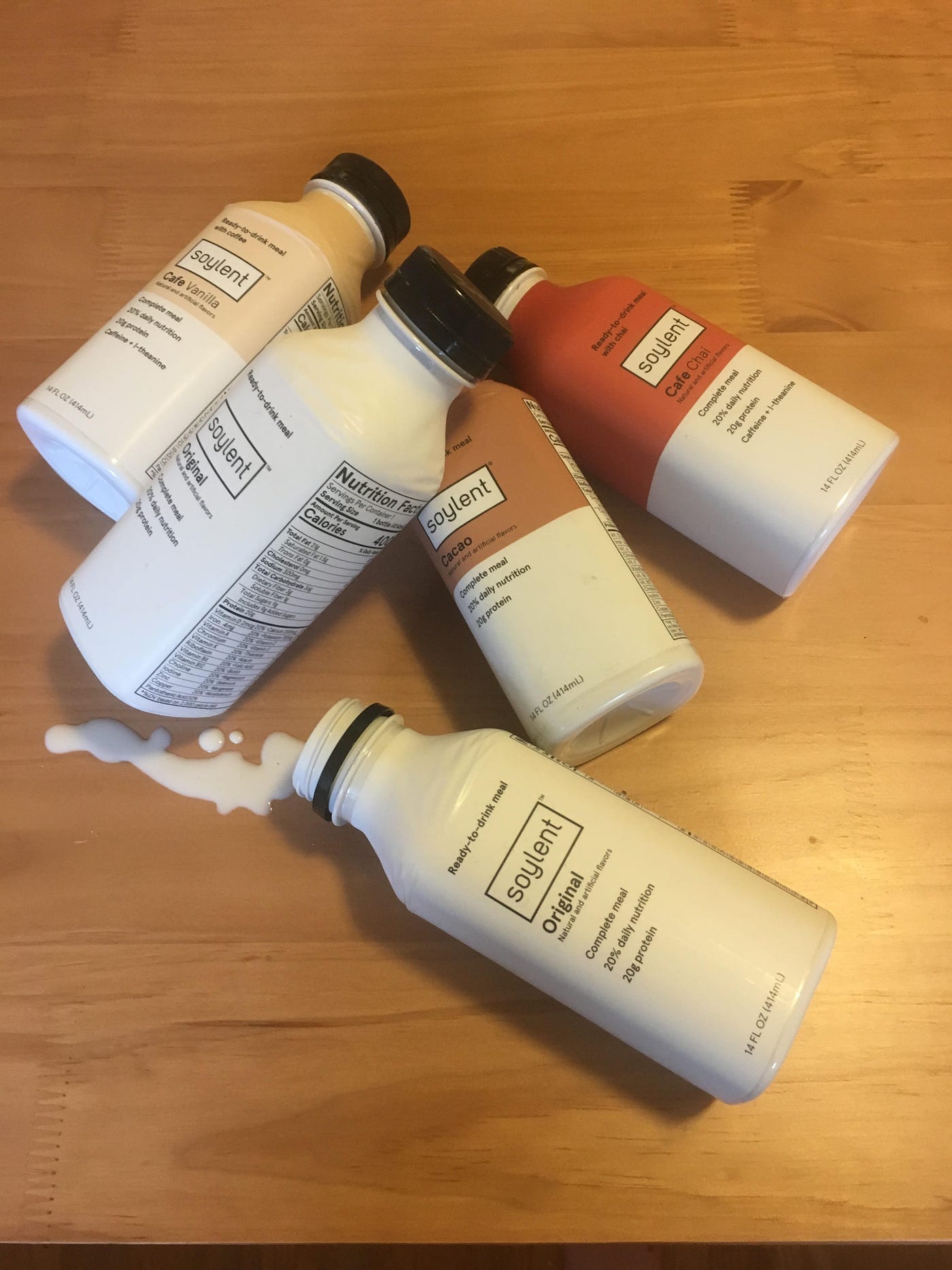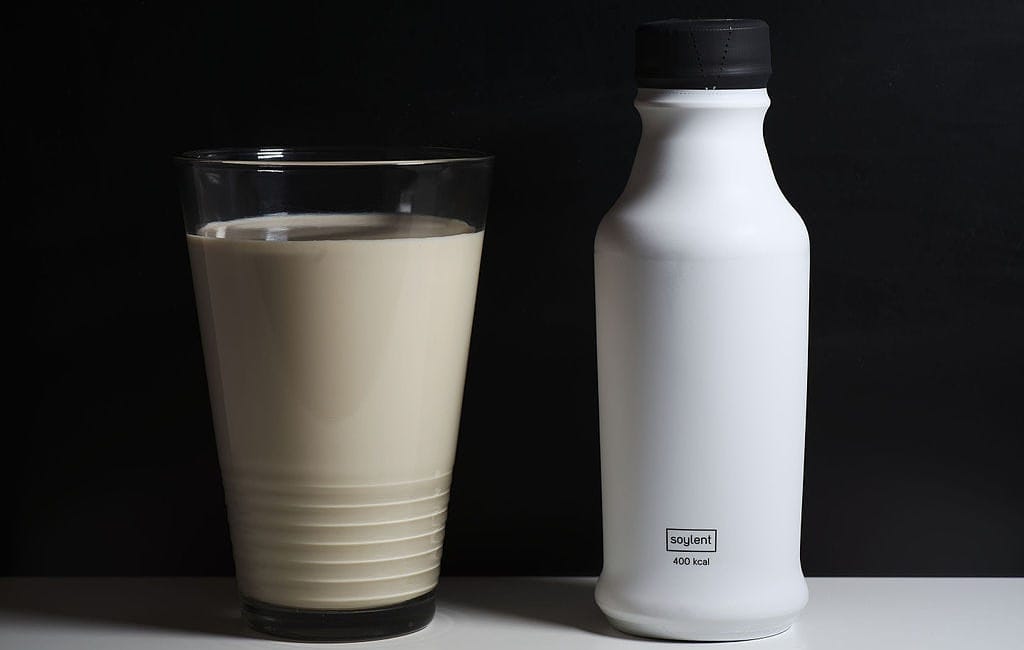
In a 2013 interview with Motherboard, Rob Rhinehart, the now former CEO of Soylent, shared the following thought on camera: “I think humanity is going to continue to grow. Everybody eats, and everybody needs energy. These constraints are only going to get tighter, and we’re going to have to take our understanding of the body and nutrition and design something new, make something manmade for humanity.”
It was the winter of my life when I discovered Soylent for the first time. After taking on a second job working part-time at a robotics start-up, which forced me to spend my week hustling back and forth between two sides of the Bay, Rhinehart’s message about tight resources began to resonate with me. Everything in my life felt tight—my time, my energy, my money, the space in my apartment, my jeans. Everything. Like when my mocking the use of “LOL” morphed into an earnest adoption of the abbreviation, the free bottles of Soylent stocked in my company’s kitchenette refrigerator that I mocked with coworkers and friends as a silly start-up affectation began to seem like an actual solution to some of my stressors. I would have free access to breakfast, lunch and dinner out of a box approximately 20 feet from my desk without the hassle of buying, preparing and cleaning up after meals.
Original Soylent can be described a bowl of Lucky Charms if you took all the charms out and just let the milk and the other white non-exciting bits sit in a bowl and thicken.
Truth be told, I thought the Soylent phenomenon had already come and gone before the time I joined the start-up game. But the company’s recent announcement of the replacement of its eccentric CEO and efforts to appeal to customers beyond the start-up scene by striking deals with 7-Eleven and Walmart reintroduced the dystopian brand name back into water-cooler conversations.
One afternoon over lunch, a coworker of mine regaled our 20-person start-up with a story about a “Soylent challenge” he undertook with his roommate. He claimed to drink nothing but the meal-replacement drink infamous for its indeterminate consistency and minimalist branding for one month. “Norman is alive and outwardly healthy looking,” I thought, foolishly. “If this kid can do it for one month, I can put up with it for one week.” Little did I know that Norman was a ripe 21 years old, an age when you can basically inject black-tar heroin on a fairly regular basis and remain unscathed. He was also mentally disciplined enough to do the challenge for no money and no reward beyond being called “My Liege” around his apartment. Unaware of these particulars at the time, I had already announced to everyone that I, too, would be embarking on a challenge of my own. As of the following morning, I would be ingesting nothing else but Soylent for the next week. I would become like the work-efficient robots my company designs. This is my story:
Day 1—10:00 p.m.
Throughout the day, I worked out that the flavor of Original Soylent can be accurately described in one of two ways: a bowl of Lucky Charms if you took all the charms out and just let the milk and the other white non-exciting bits sit in a bowl and thicken without the milk spoiling, and pancake mix. Little did I know my puer aeternus and love of breakfast foods would be my secret weapon to beating this thing.
Day 2—1:20 p.m.
This is my fifth time peeing today. I’m no doctor, but I’m putting this down as a potential cause for concern. I feel fine—not great, but fine. This challenge is an exciting but slightly nerve-wracking departure from the norm, like a sleepover with cousins or drinking a regular Coke.
Day 2—4:46 p.m.
Third bottle of the day, seventh bottle overall. I down it in about three minutes, followed by three minutes of full-body chills. I’m wearing a black trench coat in the office, and Google says it’s about 70 degrees and sunny outside. My body has turned on the Soylent diet.
Then a pain somewhere from deep in my lower intestine hits me, and I imagine that there is a clay-like ball of Soylent stuck in there.
Day 3—7:00 a.m.
I have a mild din of hunger pains and an unmistakable chalk smell in my nose and mouth. I lean over to my partner for confirmation: definitely chalk. My immune system feels weakened, which I’m not too surprised about since I’ve been pumping my body full of liquid chalk for the past 72 hours. Nevertheless, I forge ahead with my day.
Day 3—2:39 p.m.
I’m dizzy at my desk and cannot concentrate on reading or writing more than a couple of paragraphs at a time. I don’t feel productive or like Steve Jobs at all. An involuntary facial-muscle twitch has sprouted over my right eyebrow. I’m not entirely sure if it’s the Soylent, but my coworker, who reads anti-aging-vitamin blogs for fun, tells me that she is suspicious of my sodium-potassium levels.
Day 3—10:05 p.m.
I’m feeling edgy staring at my friend’s plate of gnocchi and chicken paprikash Mesmerized, I forget why I’m doing this at all and reach for a piece of bread to sop up some of the sauce. Then a pain somewhere from deep in my lower intestine hits me, and I imagine that there’s a clay-like ball of Soylent stuck in there.
This image thoroughly grosses me and my unlucky companion out. I put down the bread and order a glass of red wine. The wine comes, and I swirl the glass, staring off into the distance like a wistful, unsatisfied middle-aged woman trying to puzzle together where everything went wrong as my friend’s conversation turns to Peanut’s-style “womp womp” talk. I start dreaming up ways to turn Soylent into a cocktail.
Day 4—1:06 p.m.
By now, I can’t deny it any longer—I haven’t pooped in two, maybe three, days. I’m wondering if I’m operating on a zero-waste model and am mining my brain for any lingering knowledge from AP Bio about fiber. I Google “zero waste in body, no poop?” and find a Quora thread of three scientists who report that no poop is, indeed, impossible, “or else NASA would have figured it out by now.” Good enough for me. I wait for a movement with bated (chalk) breath.
Day 5—10:00 a.m.
I wake up feeling really upset. I’m not sure if it’s the call of the void or the Soylent diet, but I feel like I have nothing to look forward to for the rest of the day, and there is not a molecule of serotonin to be found in my brain. I board BART fantasizing about my regular fluffy omelet that I usually have for breakfast, wondering how I’m going to explain the latest to my therapist.
Day 5—3:12 p.m.
People around the office are engaging with me more than usual. Do they sense I have become one of them? A techie? Are they rooting for me or against me? This whole thing feels like an unnecessary, self-inflicted initiation ritual. I feel confused. Paranoid. Who can be trusted?
Day 5—6:00 p.m.
I run into Norman as he boards the elevator to leave. “Soylent is rough diet. Help please now,” I mutter to him in broken English. “Ah man, you just need to push past the breaking point!” he says cheerfully, like a goddamn golden retriever. “The breaking point will hit, and after that you’ll feel…” The door closes, and Norman, the only person who can relate, disappears. I feel alone in a world of misery of my own creation.

Day 6—8:30 a.m.
I’m en route to the office a full hour earlier than usual in pursuit of my first meal of the day. I guess this is how employers get their employees to office on time — with the promise of free breakfast. Some hope is restored since I switched to Cacao last night and realized that today I am finally rounding the end of my dissent into hell and madness. I feel capable, but I’m fairly certain I invented a new sexual orientation after staring at many bagel sandwiches on public transportation.
Day 6—4:26 p.m.
I’m having a psychedelic experience at my desk. I look like a techie Golem with my head down and back hunched, with three empty bottles of Soylent Cacao strewn across my keyboard. I’m on the verge of hallucinating from a lack of feeling good chemicals and can feel that today has been working up to something — whether it’s the “breakthrough” or the breaking point.
Day 6—9:27 p.m.
I arise from a fever dream craving solid foods harder than at any other point during the week. I recall a vision that came to me moments ago: I could make pancakes out of the original flavor and drizzle the Cacao flavor on top as syrup. I run—physically run—into my kitchen, snatch a bottle out of the fridge, shake it vigorously and, without a beat or a second thought, dump a bit into the no-stick pan poised on my stove and crank it up to high. After a few tense minutes, the Soylent bubbles, then starts smoking, then starts evaporating into thin air.
Like many brain children of Silicon Valley, Soylent is a Band Aid — a shortsighted, slapdash solution to fundamental issues of exploitation, sustainability and basic human rights.
My smoke alarm starts going off, but I don’t care. I’ve snapped and devolved into an animalistic state, like some real hunter-gatherer, fight-or-flight shit. I concoct the gnarliest omelet of my life (three eggs, three tablespoons of butter, fistfuls of my roommate’s fresh rosemary and basil leaves) and snarf it down in under 30 seconds. It is the best thing I’ve ever tasted.
What did I learn from all of this, you ask? Quite simply: I am not a robot. I am a human being.
There are several legitimately exciting qualities to Soylent. At $2.80 per bottle, it’s magnitudes cheaper than most meals to be found in San Francisco. It’s made up of entirely plant-based materials, and production has a low CO2-emissions output. It’s even vegan.
But the notion that human beings should or even could thrive on a long-term Soylent diet seems foolhardy at best—downright dangerous at worst. The company itself seems to have internalized this point to some degree. In a blog post announcing Rhinehart’s stepping down as CEO, the new leader, Bryan Crowley, all but downgraded the drink from the key to transcending the human need for food to PediaSure for millennials.
Like many brain children of Silicon Valley, Soylent is a Band Aid — a shortsighted, slapdash solution to fundamental issues of exploitation, sustainability and basic human rights. Why don’t we have enough time to eat food? Why does the USDA subsidize the production of crops that make up the least healthy foods? Why do 41 million Americans struggle with hunger in one of the wealthiest nations in the world? Improving our society will come down to addressing these questions, not chugging bottles of chromium-rich jizz juice.
The infamous screed that launched Rob Reinhart into notoriety about how he “stopped eating food” has since been replaced by a blank webpage bearing a cryptic quote from Emerson’s “Nature”: “Every man’s condition is a solution in hieroglyphic to those inquiries he would put. He acts it as life, before he apprehends it as truth. In like manner, nature is already, in its forms and tendencies, describing its own design.” If we consider my bowel movements to be a “hieroglyphic” response to the questions we ask of nature, or nature’s way of revealing its own design, my conclusion is that no, human beings definitely should not be drinking Soylent.
On the matter, I choose to side with the opinions of another famous essayist: “One cannot think well, love well, sleep well, if one has not dined well” — Virginia Woolf.

Hey! The Bold Italic recently launched a podcast, This Is Your Life in Silicon Valley. Check out the full season or listen to the episode below featuring Aarti Shahani, technology reporter at NPR. More coming soon, so stay tuned!







